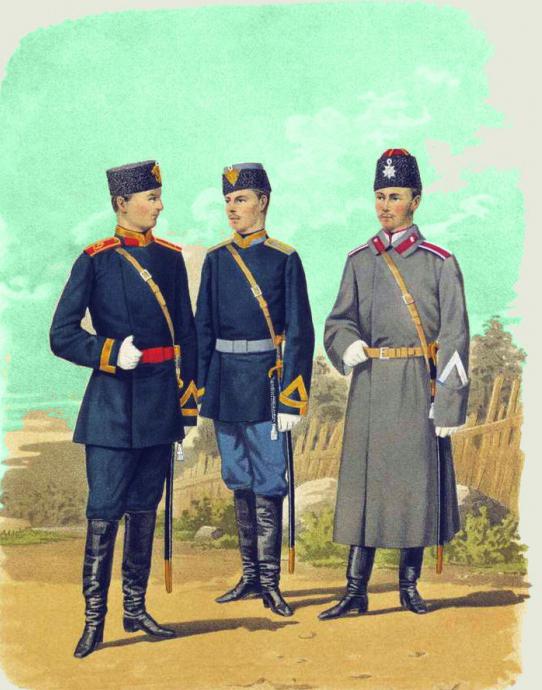The army is a special world with its own laws and customs, a strict hierarchy and a clear division of responsibilities. And the junior officers have always, starting with the ancient Roman legions, been the main connecting link between ordinary soldiers and the highest commanding staff. Today we’ll talk about non-commissioned officers. Who is it and what functions did they perform in the army?
History of the term
Let’s figure out who such a non-commissioned officer is. The system of military ranks began to take shape in Russia at the beginning of the 18th century with the advent of the first regular army. Over time, only minor changes occurred in it - and for more than two hundred years it remained virtually unchanged. After the 1917 revolution , great changes took place in the Russian system of military ranks, but even now, most of the old ranks are still used in the army.
Initially, there was no strict division into ranks among the lower ranks. In the Streltsy army, the role of junior commanders was played by officers. Then, with the advent of the regular army, a new category of lower army ranks appeared - non-commissioned officers. The word is of German origin. And this is no coincidence, since much at that time was borrowed from foreign states, especially during the reign of Peter the Great. It was he who created the first Russian army on a regular basis. Translated from German unter means "inferior."
Since the 18th century, the first degree of military ranks in the Russian army was divided into two groups: ordinary and non-commissioned officers. It should be remembered that in artillery and Cossack troops the lower military ranks were called fireworks and officers, respectively.
Ways to get a title
So, a non-commissioned officer is the lowest level of military ranks. There were two ways to get this rank. The nobles entered military service in the lowest rank immediately, out of vacancies. Then they promoted and received their first officer rank. In the XVIII century, this circumstance led to a huge overabundance of non-commissioned officers, especially in the guard, where the majority preferred to serve.
All the rest had to serve four years before receiving the rank of ensign or sergeant major. In addition, the rank of nobility could receive for special military merits.
What ranks related to non-commissioned officers
Over the past 200 years, changes have occurred in this lower level of military ranks. At different times, the following ranks belonged to non-commissioned officers:
- The ensign and mediocre-ensign are the highest non-commissioned officers.
- Feldfebel (in the cavalry, he held the rank of military commander) - a non-commissioned officer who held a middle position in the ranks between corporal and ensign. He served as assistant company commander for business and internal affairs.
- Senior non-commissioned officer - assistant platoon commander, direct commander of soldiers. He had relative freedom and independence in the education and training of ordinary soldiers. He kept order in the unit, assigned soldiers to the outfit and to work.
- The junior non-commissioned officer is the direct superior to the rank and file. It was from him that the upbringing and training of the soldiers began, he helped his wards in military training and led them into battle. In the 17th century, in the Russian army, instead of a junior non-commissioned officer, the rank of corporal existed. He belonged to the lowest military rank. A corporal in the modern army of Russia is a junior sergeant. In the American army, the rank of junior corporal still exists.

Non-commissioned officer of the imperial army
In the period after the Russo-Japanese and in the First World War, the formation of non-commissioned officers of the tsarist army was given special significance. For an instantly increased strength in the army, there was not enough officer staff, and military schools could not cope with this task. The short term of compulsory service did not allow the training of a professional military man. The War Ministry was trying by all means to keep non-commissioned officers in the army, who had high hopes for the education and training of ordinary soldiers. They gradually began to stand out in a special layer of professionals. It was decided to leave up to a third of the number of lower military ranks in long-term service.
The top-tier began to increase the monetary content, they received lump sum benefits. Non-commissioned officers who served beyond the term of 15 years, upon dismissal received the right to retirement.
In the tsarist army, non-commissioned officers played a huge role in the preparation and training of ordinary soldiers. They were responsible for the order in the units, assigned soldiers to the outfits, had the right to dismiss an ordinary soldier from the unit, engaged in evening verification.
Abolition of lower military ranks
After the 1917 revolution, all military ranks were abolished. Once again, military ranks were introduced already in 1935. The ranks of the sergeant major, senior and junior non-commissioned officers were replaced by junior and senior sergeants, the ensign became the foreman, and the mediocre ensign became the modern ensign. Many famous personalities of the 20th century began their service in the army with the rank of non-commissioned officer: G.K. Zhukov, K.K. Rokossovsky, V.K. Blucher, G. Kulik, poet Nikolai Gumilev.